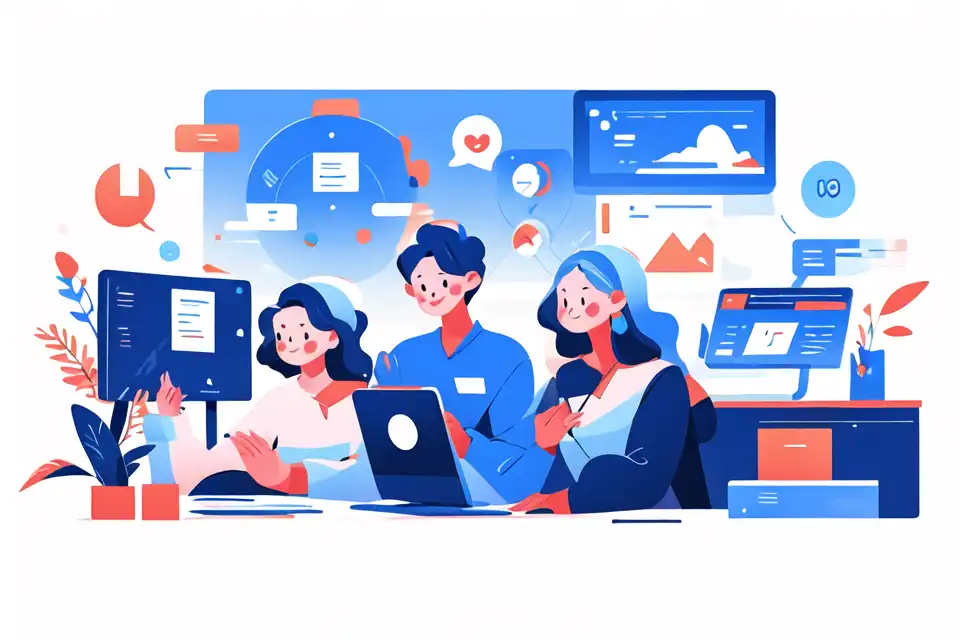AI Human-Machine Collaboration
Learn about the top tips and strategies in AI human-machine collaboration.
Try Lark for Free
In a world where digital technology is rapidly changing the face of business operations, human-machine collaboration, powered by Artificial Intelligence (AI), is becoming a game-changer. It’s paving the way towards a new era of digital strategy where humans and machines unite, streamlining operations, fostering innovation, and driving extraordinary business results. This article unfolds the fascinating journey of AI human-machine collaboration, highlighting its value in reshaping digital strategies and offering insight into its implementation in the modern workplace.
"Unlock the power of Lark to elevate your business operations."
An overview of ai human-machine collaboration in digital strategy
Defining AI Human-Machine Collaboration within the Business Landscape
AI human-machine collaboration is a cutting-edge approach where humans and AI-based machines work synergistically, enhancing each other's strengths and compensating for weaknesses. In the business landscape, this collaboration is not about replacing humans with machines. Instead, it's about harnessing AI's power to augment human capabilities, thereby taking productivity, creativity, and decision-making to unprecedented heights.
Significance of AI Human-Machine Collaboration in Today's Corporate Ecosystem
In today's ever-evolving corporate ecosystem, AI human-machine collaboration holds immense significance. It is a transformative force that redefines traditional work structures, enhances productivity, and drives innovation. By automating repetitive tasks, AI allows humans to focus on strategic planning and creative tasks, leading to improved business outcomes.
Interesting Statistics and Trends in AI Human-Machine Collaboration
A study conducted by Accenture reveals that AI could increase business productivity by up to 40% by 2035. Furthermore, Gartner predicts that by 2022, 70% of enterprises will experiment with immersive AI as part of their digital strategy, signifying the growing prominence of AI human-machine collaboration.
The role of ai human-machine collaboration
How AI Human-Machine Collaboration Boosts Workplace Productivity and Innovation
AI human-machine collaboration has the potential to revolutionize the workplace. It automates routine tasks, freeing up human employees to focus on complex, high-value activities that require creativity and strategic thinking. This not only boosts productivity but also fosters a culture of innovation in the workplace.
Benefits of AI Human-Machine Collaboration for Organizations and Employees
AI human-machine collaboration brings an array of benefits for both organizations and their employees. For businesses, it leads to increased productivity, improved decision-making, and enhanced competitiveness. Meanwhile, employees enjoy a more engaging and fulfilling work experience, with opportunities to focus on strategic and creative tasks.
Learn more about Lark can help you with everything mentioned in the article.
Implementation strategies for ai human-machine collaboration
Steps to Integrate AI Human-Machine Collaboration into Existing Work Processes
Implementing AI human-machine collaboration involves a systematic approach. First, businesses need to identify tasks that can be automated. Next, they must select the right AI tools to perform these tasks. Lastly, they should train employees to effectively collaborate with these AI systems, ensuring a seamless integration into current work systems.
Best Practices and Methodologies for Effective AI Human-Machine Collaboration Adoption
For successful implementation, businesses must foster a culture of acceptance towards AI, provide ongoing training to employees, and continuously monitor and adjust AI integration strategies based on feedback and performance.
Technological considerations for ai human-machine collaboration
Tools, Platforms, and Technologies Related to AI Human-Machine Collaboration
Various tools, platforms, and technologies facilitate AI human-machine collaboration. These include AI-powered chatbots for customer service, predictive analytics tools for data analysis, and intelligent automation platforms for process automation.
Integration of AI Human-Machine Collaboration with Existing Business Systems and Workflows
Seamless integration of AI human-machine collaboration into existing business systems and workflows is crucial for success. This requires a comprehensive understanding of existing work processes, meticulous planning, and the right technology infrastructure.
Learn more about Lark can help you with everything mentioned in the article.
Case studies in ai human-machine collaboration
Organizations Successfully Leveraging AI Human-Machine Collaboration
Many organizations have successfully harnessed AI human-machine collaboration, showcasing its transformative potential. One such organization managed to double its productivity by automating routine tasks and enabling employees to focus on strategic initiatives.
Outcomes and Key Takeaways from Successful AI Human-Machine Collaboration Implementations
Successful implementations of AI human-machine collaboration offer valuable insights. For instance, they reveal that a well-planned and executed AI strategy can lead to significant productivity gains and innovation. Also, they highlight the importance of ongoing training and change management in ensuring successful AI integration.
Challenges in ai human-machine collaboration
Common Obstacles and Risks in AI Human-Machine Collaboration
Implementing AI human-machine collaboration comes with certain challenges. These include data privacy concerns, potential job displacement, and resistance to change among employees.
Mitigation Strategies and Solutions for AI Human-Machine Collaboration Challenges
These challenges can be mitigated through robust data privacy policies, reskilling and upskilling initiatives, and effective change management strategies.
Learn more about Lark can help you with everything mentioned in the article.
Future trends in ai human-machine collaboration
Emerging Applications of AI Human-Machine Collaboration in Various Industries
AI human-machine collaboration is poised to revolutionize various industries, from healthcare and finance to retail and manufacturing. Emerging applications include AI-assisted diagnosis in healthcare, AI-powered financial analysis, and AI-enhanced supply chain management.
Preparing for Future Developments in AI Human-Machine Collaboration and Workforce Evolution
To stay ahead, businesses must keep pace with evolving AI technologies, prepare their workforce for AI integration, and foster a culture of continuous learning and innovation.
Conclusion
AI human-machine collaboration holds the key to a new era of digital strategy. By harnessing AI's power, businesses can reinvent their work processes, boost productivity, foster innovation, and stay competitive in the digital age. It's about time organizations embraced this transformative force, paving the way for a future where humans and machines work together, not against each other.
Learn more about Lark can help you with everything mentioned in the article.
"Unlock the power of Lark to elevate your business operations."








